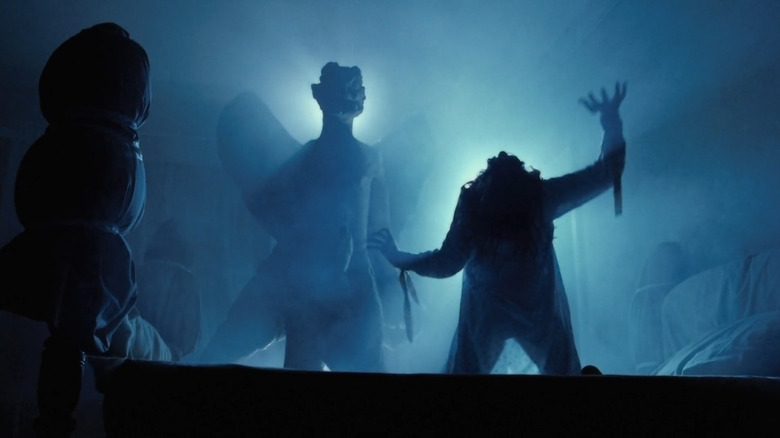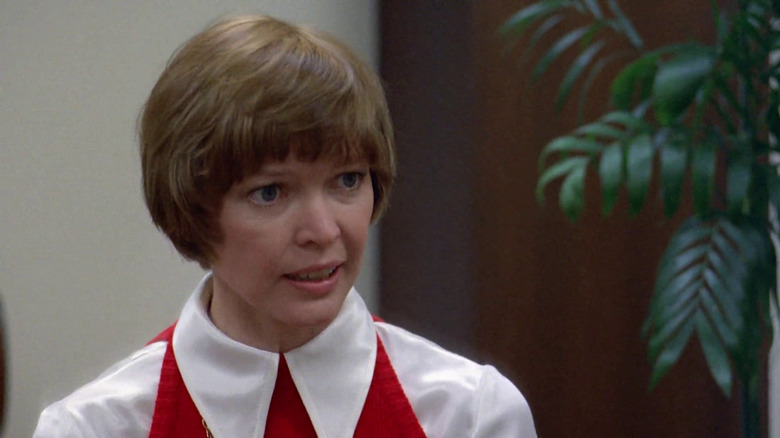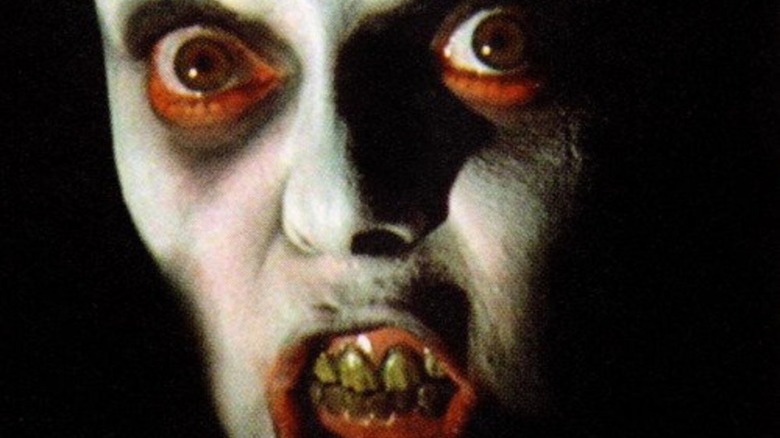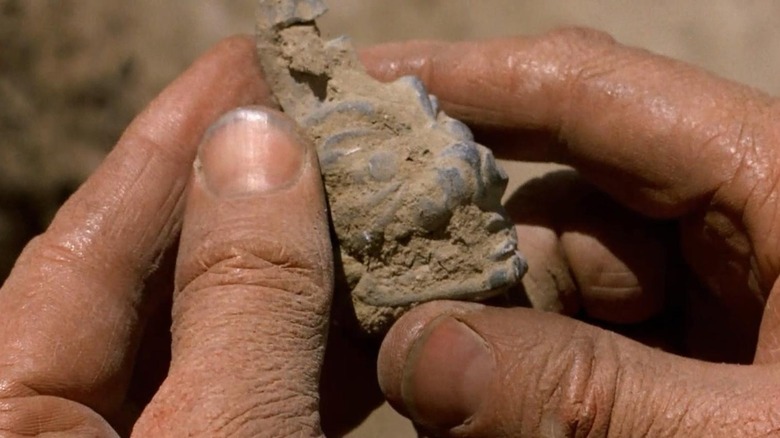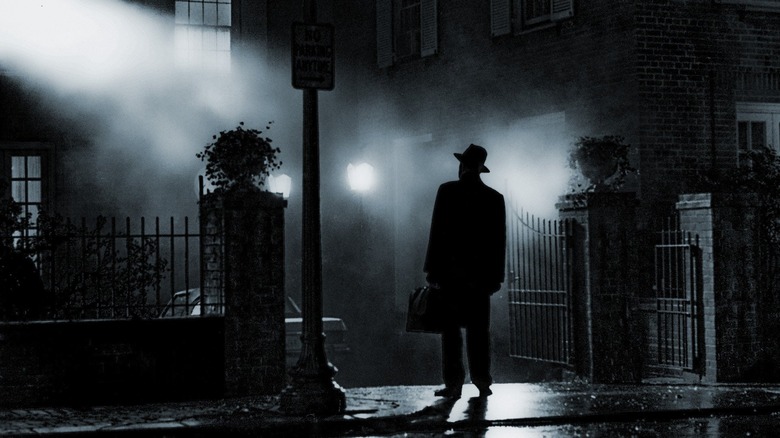The Exorcist's Real-Life Curse Is Absolutely Terrifying
What does it mean that a film is "cursed?"
There are several films throughout the medium's history that seem to have accumulated a husk of evil; Films wherein actors or filmmakers came to untimely ends, or there were more disasters on set than average. Horror films in particular seem to acquire these dark legends more commonly (there are no curses reported from the set of "Police Academy 3: Back in Training," for instance), and the horror-centric streaming service Shudder delves into five of the better known cursed films in Jay Cheel's aptly-titled documentary series "Cursed Films." In the first episode of the series, Cheel looks deep into William Friedkin's 1973 hit film "The Exorcist," what the curses were, and why curses seem to have accumulated around it.
"Cursed Films," to clarify, is never disrespectful or lascivious in its look at curses, understanding that when someone dies during the production of a film, it's indeed a very sad day. When someone dies because of a bad stunt or special effects mishap (both "The Crow" and "The Twilight Zone: The Movie" are covered in the series), it's a horrible tragedy and we need to look at ways to make movie sets safer. In the episode centering on "Poltergeist," the people who talk about the cast members who died speak of them with reverence, respect, and sadness. "Cursed Films" is a series more about the phenomenon of bad film productions, and less a deep look into the nature of evil.
Although the show's debut episode on "The Exorcist" does brush up against that, having employed philosophers and priests to talk about the nature of evil, and how horror and religion often find themselves unlikely bedfellows in humanity's need to confront and deal with evil and death.
The Curses
"The Exorcist" had numerous deaths and disasters on set. The brother of Max von Sydow (who plays Fr. Merrin) died on the first day of shooting. One of the technicians who worked on refrigerating the film's set (young Regan's bedroom was made to be so cold that you could see the actors' breath plumes) passed away during production. There was a fire that destroyed most of the film's sets ... except, curiously, Regan's bedroom where the demonic being makes its appearances. This incident led the filmmakers to hire an actual Jesuit priest to come in and bless the set.
Both actress Ellen Burstyn (who played Chris MacNeil) and Linda Blair (Regan) suffered back injuries on set, although that was because the stunt harnesses they were attached to were handled a little too roughly by technicians. These stories were only sensationalized by additional reports that director Friedkin would keep the entire cast and crew on edge by occasionally firing guns into the air to startle people, and by playing very loud music on set between takes.
There was also the dark fact that one of the medical technicians who worked on the angiography sequence, one Paul Bateson, was convicted of murdering a Variety reporter named Addison Verrill. Bateson never provided a motive, and served 24 years in prison before being released on parole. The murder of Addison Verrill would provide inspiration for Friedkin to make his 1980 film "Cruising," about an undercover cop investigating a serial killer in New York's gay leather scene.
The Hysteria
Because "The Exorcist" tapped into such powerful religious iconography, and because it dealt — terrifyingly — with notions very familiar to practicing Roman Catholics, it was immediately a sensation. Billy Graham, the televangelist, declared that, in making a movie about demonic possession, the actual film stock on which "The Exorcist" was printed was itself also possessed. As a film projectionist, I personally find this notion fascinating. Additionally, there were reports of audiences fainting or vomiting in the theater because "The Exorcist" was so intense.
For Catholics, "The Exorcist" laid bare, in literal terms, the constant struggle between Christ and the Adversary, and underlined that church officials do indeed have the power to repel actual evil. I recall film critic Roger Ebert once taking pride in his Catholic upbringing when it come to possession thrillers, as only Roman Catholics were equipped with dealing with monsters and the undead; a Presbyterian minister, for instance, would simply not do.
After the release of "The Exorcist," not only did a slew of imitators and ripoffs hit the film market, but actual instances of real-world demon possessions began to increase. Demand for exorcisms — something that Catholics might have already been familiar with — also went up. One can chalk this up to a certain kind of religious hysteria, or perhaps there was something demonic lurking in the film stock of "Exorcist" prints.
The Amulet of Pazuzu
There have been rumors — but only rumors — that the demonic amulet in "The Exorcist" was also a cursed object. The truth is less interesting, unfortunately. In the opening sequences of "The Exorcist," we see Father Merrin at an archeological site in Iraq unearthing an amulet with a demonic face. It is the Amulet of Pazuzu. The appearance of this amulet will end up connecting to Merrin's eventual confrontation with a demon all the way across the globe in Georgetown. Although the amulets look convincing, and the iconography of the demon read as being impossibly ancient, the version of Pazuzu seen in the movie is, in fact, invented.
Indeed, the name Pazuzu wasn't even mentioned in the 1973 feature film, and was later revealed in John Boorman's trashy sequel "Exorcist II: The Heretic" to be the name of the demon that possessed young Regan. Pazuzu is indeed a real deity from Babylonian mythology, but author William Peter Blatty — who wrote the original 1971 novel — created a version of Pazuzu that is an amalgam of several Assyrian and Babylonian deities. According to actual myth, Pazuzu is so frightening, he can scare off other, lesser demons, leading some ancient people to wear Pazuzu amulets as protection. In ancient Babylonian tradition, truly evil deities were not depicted in art for fear of evoking the actual demon; it's the reason you won't find many images of Erishkegal, the Queen of the Underworld. In the film version of "The Exorcist," it is stated that young Regan is possessed by the straight-up Christian version of The Devil. The book and the sequel make more explicit that Pazuzu is the one to blame.
Omitting Pazuzu from the film may have been a wise move on Friedkin's part. Pazuzu, after all, is not a modern, American monster, but an "exotic" being from a foreign land. In importing the demon to America from another continent, there is an air of xenophobia hanging around it. If Friedkin had named Pazuzu, "The Exorcist" would be less about the confrontation of tangible, palpable evil as it may still exist in the modern world, and more about a bigoted, run-of-the-mill American fear of The Other, of the foreigner.
Horror and the Problem of Evil
Returning briefly to the public hysteria surround "The Exorcist" for a moment, we may be able to really pin down why the film is considered cursed — and these concepts are discussed openly in Shudder's series. Horror and religion make for unlikely, but entirely natural bedfellows. Both horror and theology are, after all, facing the age-old philosophical Problem of Evil; in short: How can there be a benevolent God in the world if evil exists? Isn't the existence of evil proof that God is not powerful enough to defeat it, or indeed that there is no God at all? Religion wrestles with evil, often presenting philosophies and dogma that — in better circumstances — allow its adherents to go through the world with the wherewithal to aid other human beings, and fight evil on the ground, as it were. In a way, this is also the purview of horror as a genre. It presents stories where evil, death, and violence are real things that can be fought, even if it's in a silly way like spraying vampires with squirt guns filled with holy water.
In both cases, evil often triumphs, but both horror and religion are institutions made to confront the senseless horror and death we often witness around us. If that's the case, "The Exorcist" allows us to face evil, face our own demons, realize that evil is something that can indeed be confronted, and — in the case of "The Exorcist" — ultimately defeated. and if that's the case, then "The Exorcist" is not cursed, but blessed.
